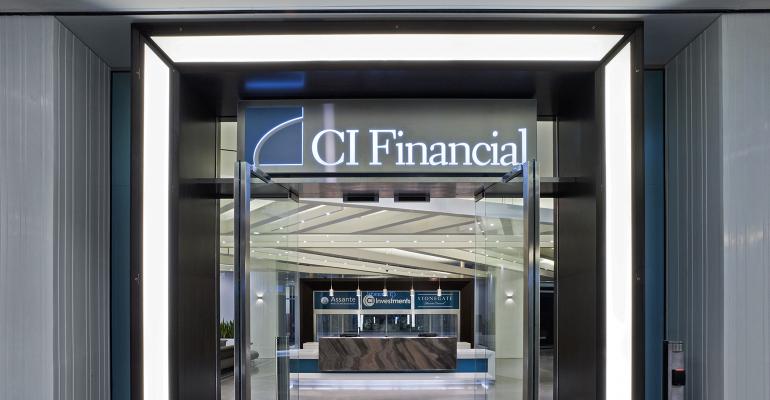Toronto-based CI Financial released Q4 earnings for 2022 on Friday morning, providing an overview of the quarter and reassuring investors that a planned U.S. IPO will help pay down an expanded credit facility and debt ratio over 4%—while also suggesting that an aggressive, years-long acquisition strategy in the states could be slowing.
Following a massive reorganization, CI comprises three distinct segments: its legacy Canadian asset management business and two advice-driven wealth management businesses, one based in Canada and the other in the U.S.
“In the fourth quarter, robust net flows in our Canadian and U.S. businesses, along with the acquisition of three best-in-class U.S. registered investment advisor firms, drove double-digit asset growth,” said CEO Kurt MacAlpine.
CI increased assets across all three segments by 11.2% over the previous quarter to $275.5 billion (in U.S. currency). This was driven, in large part, by the U.S. acquisitions of Eaton Vance WaterOak, Inverness Counsel and Kore Private Wealth, which prompted the company to lease a 50,000-square-foot office space in midtown Manhattan and added approximately $18.4 billion in assets, growing the U.S. wealth management business to nearly $133 billion at year-end.
Those totals are down slightly from the same period the previous year, when CI recorded close to $276 billion in assets across all segments. According to MacAlpine and CFO Amit Muni, this drop is due primarily to drawdowns on the asset management side, which still saw above-average inflows compared with the larger Canadian market.
“We ended 2022 with strong Q4 results, capping off a successful year where we executed well and made material progress against our strategic initiatives,” MacAlpine said, noting that the company’s adjusted earnings per share came in at 54 cents. A small increase over the previous quarter and down from 63 cents at the end of 2021, the results are still CI’s second-best on record and 27% higher than the next-best year.
“This reflects lower average AUM in our asset management business, more than offset by stronger profitability from our Canadian and U.S. wealth business for the full year,” said MacAlpine. “This performance was achieved with significant market headwinds, as 2022 was the worst market performance for a diversified 60/40 portfolio in 85 years.”
CI Financial is currently in the process of spinning off the U.S. wealth management business from its Canadian concerns. The company filed an S-1 with the U.S. Securities and Exchange Commission in late 2022 and delisted from the New York Stock Exchange in mid-January. Going forward, the Canadian businesses will trade in Canada and the U.S. wealth business will trade exclusively in the U.S.
At least part of the proceeds from the IPO are going to go toward paying down approximately $4.2 billion in net debt, all of which will be kept on the Canadian balance sheet.
“Debt is up due to the use of our credit facility to close on three RIA acquisitions in the quarter,” said MacAlpine, who repeatedly told investors the U.S. sale would reduce debt in Canada while also noting that the company "recently amended our facility to increase our max leverage to 4.75 times."
Much of the liability incurred by CI over the past four years is directly related to spending on RIA acquisitions in the states, and investors on Friday appeared to wonder whether continuing at that pace could present future risk.
“For us, M&A is a function of the quality of firms that are coming to market at that respective point in time and how they will help us achieve our overall aspiration,” MacAlpine said, adding that there are "no planned cash outlays for the rest of the quarter associated with acquisitions.”
Ultimately, while Q4 adjusted revenues increased by approximately 4.7% over the previous quarter to $455.5 billion, adjusted expenses grew by more, at around 6.1% over Q3, to $302.3 billion—directly due to the acquisitions. Once the IPO is complete, MacAlpine has indicated that no Canadian resources will go toward stateside M&A activity.
He has also said that up to 20% of the business will be sold in the offering but parried questions on Friday about how much the Canadian parent will decide to part with.
“As we work our way through the process, we'll get a better sense for what that ultimately looks like,” he said. “But we don't have a target percentage that we're looking to sell or a specific number that we're managing for. We're looking to maximize the value for our Canadian shareholders while allowing CI to retain meaningful ongoing participation in that business.”
Maintaining that CI is “not an aggregator,” MacAlpine said the company’s goal is to become “the leading integrated ultra-high and high-net-worth manager in the U.S.—period.” This will be accomplished through strong organic growth and full integration of a new operating platform, he said, in addition to continued targeting of attractive wealth management firms.
CI’s adjusted EBITDA was about $178.2 billion in Q4 2022, compared with $203.5 billion at the end of 2021. The company’s board declared a quarterly dividend of 13 cents per share for the quarter and the annual dividend rate of 53 cents represents a 4.7% yield on CI’s closing share price on Thursday.
More detailed information on CI financials can be found here and here.





